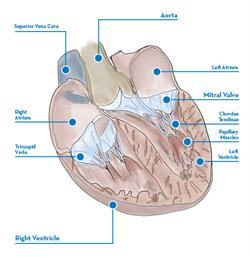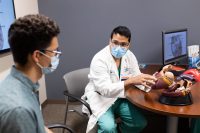Mitral Valve Surgery
If you have mitral valve disease, Florence Wormald Heart & Vascular Institute at St. Elizabeth Structural Heart and Valve Center offers a range of options for mitral valve repair and replacement led by Greater Cincinnati’s most experienced surgeon in minimally invasive mitral valve surgery. We perform endoscopic minimally invasive mitral valve surgery even for complex cases, using a small incision between the ribs on the right chest. Our heart experts also have options to implant a MitraClip™ device to reduce valve leakage in high-risk surgical candidates, or conventional open heart surgery when necessary.
Mitral Valve Surgery Treatments
Medications and healthy lifestyle changes often can improve symptoms of mitral valve disease, but they do not stop progression of the disease. As the disease worsens, many people with mitral valve disease may require heart valve surgery to repair or replace a mitral valve.
Our experts believe that early action to repair the mitral valve can prevent irreversible damage to the valve and the heart and offer a better quality of life in the short and long term.
Contact Us
To learn more about mitral valve surgery, contact the Nurse Navigator at the Florence Wormald Heart & Vascular Institute at St. Elizabeth Structural Heart and Valve Center.
Options for treatment include:
Minimally Invasive Mitral Valve Surgery

During valve surgery, the physician makes a one to one-and-a-half-inch incision (figure 1) in the right chest between the ribs. The surgeon uses long, thin instruments to work inside the heart and repair the valve. The patient is connected to a heart-lung machine to redirect blood flow and stop the workload of the heart during the procedure.
The mitral valve is like the canopy of a parachute (figure 2) with chords that anchor to muscles and hold the valve in place. If one of the chords becomes stretched or damaged, it can cause imbalance and leakage back into the upper heart chamber.

Our surgeons prefer to repair rather than replace a valve for degenerative disease, since your own valve will last much longer than an artificial valve. There are cases, however, where your own valve is damaged beyond repair. In these situations, using a mechanical valve or one made from cow, pig or human heart tissue is the best option.
A minimally invasive valve repair or replacement typically allows a shorter hospital stay, quicker recovery, fewer blood transfusions and less pain than conventional open heart surgery. On average, patients remain in the hospital for three to five days. The recovery period is about three weeks. Some people resume office work two weeks after going home.
In addition, studies now show this minimally invasive approach offers better outcomes in mitral valve repair than the robotic approach¹, with shorter recovery than conventional open heart surgery. For that reason, the procedure is quickly becoming the new gold standard in centers of excellence.
MitraClip™ Device
For those who are not a candidate for valve surgery due to health risks, a MitraClip device, about the size of a small paper clip, is used to clamp together the two leaflets of the mitral valve. This closes the valve more completely to reduce leakage.
Our interventional cardiologists insert a narrow tube called a catheter in a vein at the top of the leg and advance the MitraClip to the mitral valve in the heart. It is precisely positioned above the leak in the valve, and the arms of the clip hold the valve leaflets together to reduce blood seeping back into the atrium.
Patients generally go home from the hospital the next day, and recovery time at home is minimal. Most patients see significant improvement in their symptoms and their quality of life soon after the procedure.
Conventional Open Heart Surgery
During conventional open heart surgery to repair your own valve or replace it with a biological or mechanical valve, your surgeon will make an incision down the middle of your chest and cut open your breastbone to access your heart. This opening of the breastbone is called a sternotomy.
You will be put on a heart-lung bypass machine during the procedure, which will do the work of your heart. This allows your heart to be still during the procedure.
In the past, conventional open heart surgery was the only way to perform mitral valve surgery. Today, it is still an important option for certain complex or emergency cases.
After conventional open heart surgery, you will typically recover in the hospital for five to seven days. You can resume most activity in about four to six weeks. For the first six weeks, however, you will not be able to lift heavy objects or perform activities that strain your upper arm muscles or chest muscles.
Understanding Mitral Valve Disease
Your mitral valve is one of four heart valves that regulate the flow of blood through your heart. This one-way valve has two flaps that open and close to permit blood flow from the left atrium (upper heart chamber) into the left ventricle (lower, main pumping chamber). It is the most commonly repaired heart valve.
In general, there are three main types of mitral valve disease:




